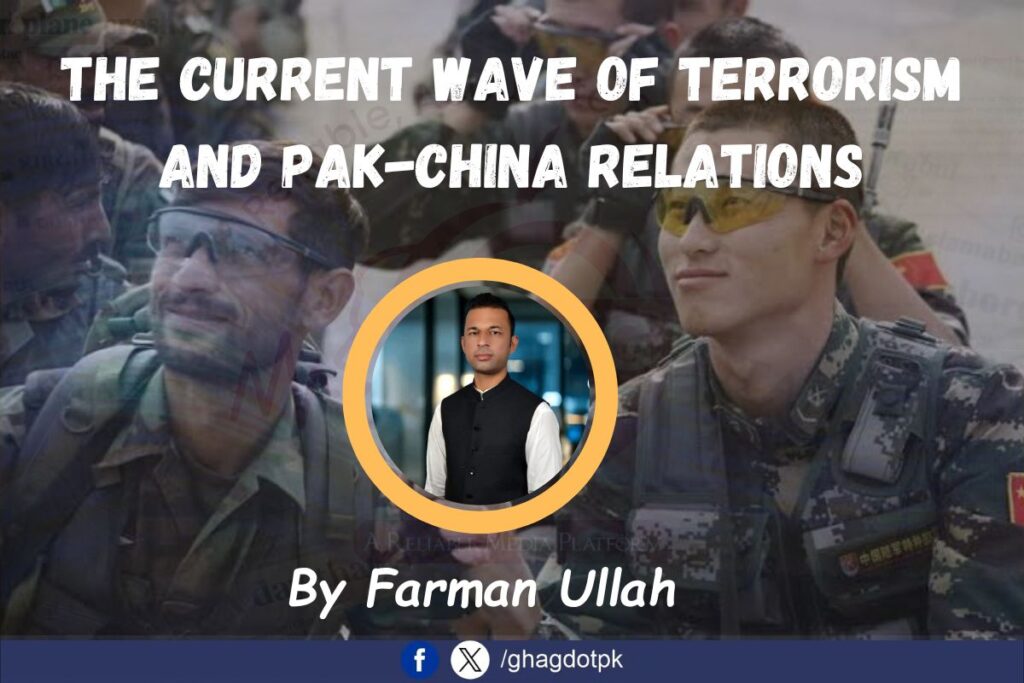By Farman Ullah
Terrorism is a complex phenomenon, reason why there is no common agreed definition. According to the Global Terrorism Database terrorism is defined as “the threatened or use of illegal force and violence by a non state actor to attain political, religious or social goal through fear, coercion or intimidation”
The overall line and order situation in the country is not good, particularly situation in KP and Balochistan has reached a critical juncture, with the looming possibility of military action. However, despite the urgency of the situation, political dialogue remains an essential component in addressing the crisis in the long term. The involvement of external actors, particularly China, and the broader geopolitical dynamics, will significantly shape how the conflict unfolds.
China’s Pivotal Role
China’s role in the conflict is pivotal, driven by its strategic interests in Balochistan, notably through the China-Pakistan Economic Corridor (CPEC). China’s security concerns regarding its nationals in the region have also intensified, particularly in the wake of attacks by the Baloch Liberation Army (BLA) on Chinese interests.
While China has expressed support for Pakistan’s counterinsurgency efforts, it has remained cautious about direct military involvement. China’s hesitation stems from a broader reluctance to become embroiled in military conflicts in neighboring countries, despite its substantial investment in the region.
Historical Precedents and Future Possibilities
Historical precedents, such as China’s role during Pakistan’s operations like Zarb-i-Azb, suggest that while China is unlikely to deploy military forces directly, it could offer intelligence-sharing, training, and potentially supply equipment, enhancing Pakistan’s capacity to handle insurgents more effectively.
However, the economic constraints on Pakistan’s side complicate this scenario, as full-scale military operations are costly and the state already faces challenges in managing other insurgent threats. The possibility of China providing more comprehensive support, whether through surveillance equipment, military hardware, or partial funding, remains speculative but is not out of the question, especially if the threat to Chinese interests escalates further.
Balancing Military Responses and Political Solutions
For Pakistan, stabilizing Balochistan requires a delicate balance between military responses and political solutions. However, the state seems reluctant to initiate a deeper political process or dialogue, fearing it could undermine its control. The reluctance of political leadership to engage in a meaningful dialogue adds complexity to the situation.
Without a political resolution, military operations, while effective in addressing immediate security threats, may not resolve the underlying grievances that fuel the insurgency. Addressing these grievances requires a nuanced understanding of the local population’s concerns and a willingness to engage in meaningful dialogue.
Regional Stability and Cooperation
In terms of regional stability, Pakistan and China will likely continue to develop a framework of cooperation that avoids direct military involvement but enhances Pakistan’s internal security through intelligence-sharing and other forms of support. Both nations share a vested interest in ensuring Balochistan remains stable to protect their strategic and economic objectives, particularly CPEC.
However, achieving this balance will require careful diplomacy, particularly with respect to managing the Baloch separatist movement and addressing the concerns of the local population in Balochistan. This could remain a volatile challenge even with external support.






